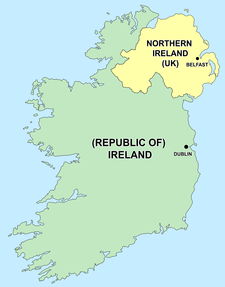Irish question
The Irish Question was a phrase used mainly by members of the British ruling classes from the early 19th century until the 1920s. It was used to describe Irish nationalism and the calls for Irish independence.

The phrase came to prominence as a result of the Acts of Union 1800 which merged the Kingdom of Ireland with the Kingdom of Great Britain to create the United Kingdom of Great Britain and Ireland, and merged the Parliament of Ireland into a single governing body with the Parliament of Great Britain, the Parliament of the United Kingdom based in Westminster. Doing so forced the British political class to pay attention to the state of Ireland and its people.
In 1844, a future British prime minister, Benjamin Disraeli, defined the Irish Question:
A dense population, in extreme distress, inhabit an island where there is an Established Church, which is not their Church, and a territorial aristocracy the richest of whom live in foreign capitals. Thus you have a starving population, an absentee aristocracy, and an alien Church; and in addition the weakest executive in the world. That is the Irish Question.'
— Hansard[1]
In the United Kingdom general election of 1868, a coalition of Liberals and Irish Nationalists formed based on the fact that a wrong was done to Ireland and that it must be corrected.[2] From the general election of 1868 to 1929, and most likely past the latter year, the Liberal Party's primary platform of reform was based on Irish reform.[2] During the first ministry of William Ewart Gladstone, a total of 3 "grievances" were made to him by the Irish: "religious, agrarian, and nationalist".[2] These were, but not limited to, the Roman Catholic faith being persecuted since the 16th century, the poverty wrought upon by legislation, such as Ireland's woolen industry, and English landlords, and "Poyning's Law", which held the Irish government's action subject to the acceptation of the government of England under Henry VII.[3]
In 1886, with the introduction of the first Home Rule Bill in the House of Commons, the term 'the Anglo-Irish Quarrel'[4] gained favour and became more acceptable than the implied condescension of 'the Irish Question'.
Issues relating to Northern Ireland since the 1920s are often referred to as either "The Troubles" or "The Irish Problem".
The Irish question affected British politics much the way that the nationalities problem affected Austria-Hungary. Normal British domestic issues could not be adequately addressed because of the political divisions created by the oppression of Ireland. The Liberal Party split over Home Rule, with the unionist faction leaving to create the Liberal Unionist Party, ceding control to the Conservatives, thus hurting the cause of further social and political reform.
In 2017, the term was also used to describe issues associated with the UK-Irish border and Brexit.[5][6] The term Irish border question has been used more widely in recent years.
References
- The State of Ireland, Hansard, 16 February 1844
- Hayes, Carlton J.H. (1929). A Political and Social History of Modern Europe. New York, USA: The Macmillian Company. p. 319.
- Hayes, Carlton J.H. Hayes (1929). A Political and Social History of Modern Europe. New York, USA: The Macmillan Company. pp. 320, 321, and 322.
- The Anglo-Irish Quarrel: A Plea for Peace, John O'Connor Power, London, 1886
- Toynbee, Polly (27 November 2017). "The Irish question may yet save Britain from Brexit | Polly Toynbee". The Guardian.
- "Brexit viewed from Brussels: The Irish question".